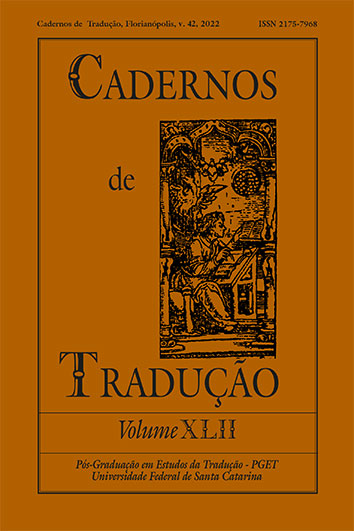How to be a (recognized) translator: rethinking habitus, norms, and the field of translation
DOI:
https://doi.org/10.5007/2175-7968.2022.e84787Keywords:
Translators, Habitus, Cultural-Professional Groups, Translation as an Occupation, Israeli TranslatorsAbstract
Focusing on translators as a cultural-professional group, this article mobilizes the Bourdieusian concepts of field and habitus for explaining the tension between the constrained and the versatile nature of translators’ action, as determined by their cultural group-identification and by their position in their specific field of action. Emphasizing the basic parameter of status contests and struggle for symbolic capital, it elaborates on three important aspects of translators’ differentiating self-images and strategies of action, using examples from the field of Hebrew translation in contemporary Israel: (1) the variability of strategies translators employ while playing either conservative or innovative roles, as cultural custodians or cultural importers, in specific historical contexts; (2) the dynamic construction and stratification of the field of translation, which results from the endeavor to establish its autonomous source of prestige, oscillating between impersonal professional status and an artistic-like personal “stardom”; and (3) translators’ preferred models of self-fashioning, according to which they select and signify the facts of their life-conditions and use them for improving their status and terms of work.
References
Abbott, A. The system of professions: An essay on the division of expert labor. Chicago & London: The University of Chicago Press, 1988.
Adorno, T.W. “On popular music”. Studies in philosophy and social science, n. 9, p.17-48, 1941.
Aldridge, M. & Evetts, J. “Rethinking the concept of professionalism: The case of journalism”. British journal of sociology, v. 54, n. 4, p. 547-564, 2003.
Ben-Ari, N. Norms underlying translation of German literature into English, French and Italian. Tel Aviv University, 1988. [Unpublished M.A. Thesis.]
Ben-Rafael, E. Language, identity and social division. Oxford: Clarendon Press, 1994.
Bourdieu, P. “La Métamorphose de gout”. In; Bourdieu, P. Questions de sociologie. Paris: Edition de Minuit, (1980a). p. 161-172.
Bourdieu, P. “Quelques propriétés des champs”. In: Bourdieu, P. Questions de sociologie. Paris:Edition de Minuit, (1980b). p. 113-120.
Bourdieu, P. “The market of symbolic goods”. Poetics, v. 14, n. 1-2, p. 13-44, 1985.
Bourdieu, P. “The economy of practices”. In: Bourdieu, P. Distinction: A social critique of the judgment of taste, tr. Richard Nice. London & New York: Routledge & Kegan Paul, (1986 [1979]). p. 97-256.
Bourdieu, P. “Codification”. In: Bourdieu, P. In other words: Essays towards a reflexive sociology, tr. M. Adamson. Cambridge: Polity Press, (1996 [1990]). p. 76-86.
Brubaker, R. “Rethinking classical theory: The sociological view of Pierre Bourdieu”. Theory and society, v. 14, n. 6, p. 745-775, 1985.
Carey, J. The intellectuals and the masses. London and Boston: Faber and Faber, 1992.
Chriss, R. The translation profession, 2000.
Collinson, J. A. “Occupational identity on the edge: Social science contract researchers in higher education”. Sociology, v. 38, n. 2, p. 313-329, 2004.
D’Andrade, R. The development of cognitive anthropology. Cambridge: Cambridge University Press, 1995.
Davis, J. “Social creativity”. In: Hann, C.N. (ed.) When culture accelerates: Essays on rapid, social change, complexity and creativity. London and Atlantic Highlands, NJ: The Athlone Press, 1994, p. 95-110.
DiMaggio, P. “Review essay on Pierre Bourdieu”. American journal of sociology, v. 84, n. 6, p. 1460-1474, 1979.
Drory, R. “Literary contacts and where to find them: On Arabic literary models in medieval Jewish literature”. Poetics today, v. 14, n. 2, p. 277-302, 1993.
Durkheim, E. & Mauss, M. Primitive classification, translated from the French and edited with an introduction by Rodney Needham. Chicago: University of Chicago Press, 1963 (1903).
Eitam, E. The formation of elite culture by high-tech employees in Israel. Tel Aviv University, Unit of Culture Research, 2003. [Unpublished M.A. Thesis.] [Hebrew]
Elias, N. The civilizing process, tr. E. Jephcott. Oxford: Blackwell. 1982 (1939).
Elias, N. The court society, tr. E. Jephcott. Oxford: Blackwell. 1983 (1969).
Elias, N. The Germans: Power struggles and the development of habitus in the nineteenth and twentieth centuries. New York: Columbia University Press. 1996 (1989).
Elias, N. Mozart: Portrait of a genius. Polity Press. 1993 (1991).
Even-Zohar, I. “The position of translated literature within the literary polysystem”. Poetics today, v. 11, n. 1, p. 45–51, 1990 [1978]).
Even-Zohar, I. “‘Reality’ and realemes in narrative”. Poetics today, v. 11, n. 1, p. 207-218, 1990a.
Even-Zohar, I. “Russian and Hebrew: The case of a dependent polysystem”. Poetics today, 11:1, (1990b), p. 97-110.
Even-Zohar, I. “Factors and dependencies in culture: A revised draft for polysystem culture research”. Canadian review of comparative literature, v. 24, n. 1, p.15-34, 1997.
Even-Zohar, I. “The making of culture repertoire and the role of transfer”. Target, v. 9, n. 2, p. 373-381, 1997a.
Goffman, E. The presentation of self in every-day life. Garden City NY, Doubleday, 1959.
Gouanvic, J. 1995. “Pour une sociologie de la traduction: le cas de la littérature américaine traduite en France après la Seconde Guerre mondial (1945–1960)”. In: Snell-Hornby, M.; Jettmarová, Z. & Kaindl, K. Translation as Intercultural Communication, 1995, p. 33-44. 1995.
Gumperz, J. J. “The retrieval of socio-cultural knowledge in conversation”. Poetics today, v. 1, n. 1-2, p. 273-286. 1979.
Harker, R.; Mahar, C. & Wilkes. C. (eds.). An introduction to the work of Pierre Bourdieu. London: Macmillan, 1990.
Hermans, T. “Translation as institution”. In: Snell-Hornby, M.; Jettmarová, Z. & Kaindl, K. Trasnslation as Intercultural Communication, p. 3-20, 1995.
Holland, D. & Quinn, N. (eds.). Cultural models in language and thought. Cambridge: Cambridge UP, 1987.
Inghilleri, M. “Habitus, field and discourse: Interpreting as a socially situated activity”. Target, v. 15, n. 2, p. 243-268, 2003.
Jänis, M. “What translators of plays think about their work”. Target, v. 8, n. 2, p. 341-364, 1996.
Jenkins, R. “Practice, habitus and field.” In: Jenkins, R (ed.). Pierre Bourdieu. London: Routledge, p. 66-102, 1992.
Kernan, A. B. “The poet’s place in the world: Images of the poet in the Renaissance”. In: Ashley, L.R.N. (ed.). The playwright as magician. New Haven & London: Yale University Press, p. 1-23, 1979.
Kuperman, A. Translation norms and uses of TV models in Israel. Seminar paper. Haifa University, Department of Hebrew and Comparative Literature, 1998. [Hebrew]
Lahire, B. “From the habitus to an individual heritage of dispositions: Towards a sociology at the Level of the individual”. Poetics, v. 31, p. 329-355, 2003.
Lamont, M. Money, morals, manners: The culture of French and American Upper- Middle Class. The University of Chicago Press, 1992.
Lamont, M. The dignity of working men: Morality and the boundaries of race, class and immigration. Cambridge, Mass.: Harvard University Press, 2003.
Lamont, M. & Fournier, M. (eds.). Cultivating differences: Symbolic boundaries and the making of inequality. University of Chicago Press, 1992.
Lau, R. W. K. “Habitus and the practical logic of practice: An interpretation”. Sociology, v. 8, n. 2, p. 369-387, 2004.
McCracken, G. “‘Ever dearer in our thoughts:’ Patina and the representation of status before and after the eighteenth century”. In: McCracken, G. Culture and consumption: New approaches to the symbolic character of consumer goods and activities. Bloomington and Indianapolis: Indiana University Press, 1990 (1988). p. 31-43.
Noble, G. & Watkins, M. “So, how did Bourdieu learn to play tennis? Habitus, consciousness and habituation”. Cultural studies, v. 17, n. 3/4, p. 520-538, 2003.
Nooy, W. The dynamics of artistic prestige. Poetics, v. 30, p. 147-167, 2002.
Peterson, R. A. “Changing representation of status through taste displays: An introduction”. Poetics, v. 25, p. 7-73, 1997.
Pinder, R. “On the margins: Belonging in general practice for women part-timer and non-principles”. Family practice, v. 15, p. 363-368, 1998.
Rapoport, T. & Lomsky-Feder, E. “‘Intelligentsia’ as an ethnic habitus: The inculcation and restructuring of intelligentsia among Russian Jews”. British journal of sociology of education, v. 23, n. 2, p. 233-248, 2002.
Sapir, E. “The unconscious patterning of behavior in society”. In: Mandelbaum, D. G. (ed.). Selected writings of Edward Sapir in language, culture and personality. Berkeley: University of California Press, 1949 (1927). p. 544–559.
Sapiro, G. Translation and identity: Social trajectories of the translators of Hebrew literature in French. Paper presented at the conference Institutions, habituses and individuals: Social, historical and political aspects of cultural exchange. Tel Aviv, May 2–5, 2004.
Schäffner, C. “The concept of norms in Translation Studies”. Current issues in language & society, v. 5, n. 1&2, p. 2-9, 1998.
Sela-Sheffy, R. Literarische Dynamik und Kulturbildung: Zur Konstruktion des Repertoires deutscher Literatur im ausgehenden 18. Jahrhundert. Gerlingen: Bleicher Verlag, 1999.
Sela-Sheffy, R. “How to be a (recognized) translator: Rethinking habitus, norms, and the field of translation”. Target, v. 17, n. 1, p. 1-26, 2005.
Sela-Sheffy, R. “The suspended potential of culture research in TS”. Target, v. 12, n. 2, p. 345-355, 2001.
Sela-Sheffy, R. The translators’ personae: Marketing translatorial images in Israel as pursuit of capital. In: Institutions, habituses and individuals: Social, historical and political aspects of cultural exchange. Conference, Tel Aviv, May 2–5, 2004.
Sheffy, R. “Models and habituses: Problems in the idea of cultural repertoires”. Canadian review of comparative literature, v. 24, n. 1, p. 35-47, 1999.
Shumway, D. “The star system in literary studies”. PMLA, v. 12, n. 1, p. 85-100, 1997.
Simeoni, D. “The pivotal status of the translator’s habitus”. Target, v. 10, p. 1-39, 1998.
Smith, E. “Ethos, habitus and situation for learning: An ecology”. British journal of sociology of education, v. 24, n. 4, p. 463-470, 2003.
Snell-Hornby, M.; Jettmarová, Z. & Kaindl, K. (eds.). Translation as intercultural communication. Amsterdam and Philadelphia: John Benjamins, 1995.
Swidler, A. “Culture in action”. American sociological review, v. 51, p. 273-286, 1986.
Stokmans, M. J.W. “How heterogeneity in cultural tastes is captured by psychological factors: A study of reading fiction”. Poetics, v. 31, p. 423-439, 2003.
Tomashevskij, B. “Literature and biography”. In: Matejka, L. & Pomorska, M. (eds.) Readings in Russian poetics. Cambridge, Mass.: MIT, 1971 (1923). p. 74-55.
Toury, G. “The nature and role of norms in literary translation” In: Holmes, J. S. et al. (eds.). Literature and translation: New perspectives in literary studies. Leuven: Acco, 1978, p. 83-100. (Revised version in Toury, G. Descriptive Translation Studies and beyond. Amsterdam & Philadelphia: John Benjamins, 1995a, p. 53-69.)
Toury, G. Descriptive Translation Studies and beyond. Amsterdam & Philadelphia: John Benjamins, 1995a.
Toury, G. “A bilingual speaker becomes a translator: A tentative development model”. In: Toury, G. Descriptive Translation Studies and beyond. Amsterdam & Philadelphia: John Benjamins, 1995a, p. 241-258.
Toury, G. “A handful of paragraphs on ‘translation’ and ‘Norms’”. In: Schäffner, C. (ed.) Translation and norms. Clevedon etc.: Multilingual Matters, 1999. p. 10-32.
Toury, G. “Translation as a means of planning and the planning of translation: A theoretical framework and an exemplary case”. In: Paker, S. (ed.). Translations: (Re)shaping of literature and culture. Istanbul: Boğaziçi University Press, 2002, p. 148-165.
Verdaasdonk, H. “Valuation as rational decision-making: A critique of Bourdieu’s analysis of cultural value”. Poetics, 31, p. 357-374, 2003.
Venuti, L. The translator’s invisibility: A history of translation. London & New York: Routledge, 1995.
Fontes
Green, Yaacov (Geofrey). “Sobre a situação do tradutor”. Yedi’ot Aharonot, v. 24, 1990. [em hebraico]
Harel, Orit. Maariv. 12.6.2003. [em hebraico]
Katzenelson, Irit. “Os novos tradutores, o estado da arte”. Yediot Aharonot 13.10.2000. [em hebraico]
Kermit Guia do Kermit para um tradutor iniciante. 1.03.2004. Nana Forums (http://Forums.nana.co.il). [em hebraico]
Lev-Ari, Shiri. “Não é semelhante aos textos fonte”. Ha’aretz 24.04.2002. [em hebraico]
Yariv, Amit. O guia compacto para contratos de trabalho. Artigo apresentado na conferência anual do ITA, February 2004. Nana Forums (http://Forums.nana.co.il). [em hebraico]
Nana translation and editing forum: http://forums.nana.co.il/Forum/?ForumID=2088
Translation fees 2003: http://planet.nana.co.il/managers/meravz/article73.html, 15.9.2003.
Translation: http://translation.israel.net/trans.php3.
Israeli translators: http://translation-il.freeservers.com/.
Tapuz forum: http://www.tapuz.co.il/tapuzforum.
Downloads
Published
How to Cite
Issue
Section
License
Copyright (c) 2022 Cadernos de Tradução

This work is licensed under a Creative Commons Attribution 4.0 International License.
Copyright Notice
Authors hold the copyright and grant the journal the right for their articles' first publication, being their works simultaneously licensed under the Creative Commons Attribution License (CC BY), which allows the sharing of such works with its authorship acknowledged and its initial publication in this journal.
Authors are allowed to enter into separate additional contractual arrangements for the non-exclusive distribution of the journal's published version of the work (e.g., post it to an institutional repository or as a book chapter, with an acknowledgment of its initial publication in this journal).








































